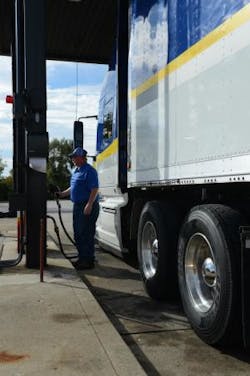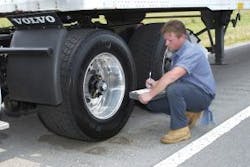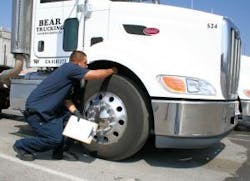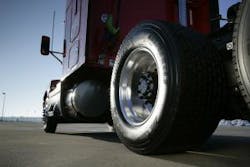Tires: From black to green
“Green is the new black” is a snappy catchphrase. Too bad it doesn’t capture all the thinking being poured into enhancing original-equipment truck tires. To be sure, there’s no getting around the seemingly endless fade to green. Truck tires are increasingly being designed to save the environment and fuel dollars. But could they get so green that their other money-saving attributes get squeezed enough to spurt red ink?
Certainly, the original equipment (OE) tires supplied to truck builders have been getting steadily greener in large part due to fleet desires to spec new trucks with tires engineered to aid fuel efficiency via lower rolling resistance.
And then there’s the significant trickle-back impact of the federal fuel-efficiency and greenhouse-gas emissions (MPG/GHG) standards. With these in place, truck OEMs have been charged with meeting specific fuel-efficiency and emissions-reduction targets arrayed along a lengthy yet urgent timeline. That’s led truck makers to turn to their tire suppliers (among others) to develop original-equipment products that will further assist them in bumping up vehicle MPGs.
But for truck tires, there’s another definition of green that must ever stay in play. As truck-tire executives tell it, fuel efficiency gains must not diminish other required performance factors of tires, such as mileage, irregular wear, traction and retreadability. In short, rolling resistance can be improved so long as the tire will also run green by delivering its expected cost-per-mile dividend to fleets.
Getting back to that newest driver of truck-tire developments, the federal MPG/GHG rules are the joint province of the Environmental Protection Agency and NHTSA. The rules consist of Phase I, covering commercial trucks from model year 2014-18, and Phase II, which will apply to vehicles starting with model year 2019.
The Phase II standards will be more rigorous. And there’s a challenging timeline facing truck makers and, by extension, their suppliers. Even though implementation of the newer rules will begin in less than five years, EPA and NHTSA have yet to release the substance of the upcoming standards.
Publicly, the agencies have said next to nothing about what will comprise Phase II. As for the Obama administration, which launched the entire MPG/GHG campaign, it has only hinted at the intent and scope of the new standards. Its most telling remark on the rules for model-year 2019 and beyond is the contention they’ll “lead to the adoption of new fuel-efficient technologies on trucks and semi-trailers.”
So, the newsflash is trailer OEMs will be legally bound for the first time to contribute to meeting federal MPG/GHG standards for commercial vehicles. And that certainly suggests that trailer tires boasting low rolling resistance will be highly sought for original fitment by builders of on-highway trailers.
Also significant is that EPA and NHTSA have been charged under Phase II with assessing “advanced technologies that may not currently be in production” within various categories. Those include shedding more vehicle weight and further lowering the rolling resistance of tires.
The upshot is that other than putting on notice the manufacturers of semi-trailers and underscoring the efficiency contribution that lower rolling resistance tires can provide, what’s been issued to date on the role of tires in Phase II is little more than a policy statement.
Although there’s no official rulebook to consult, suppliers of OE truck tires know they have their work cut out for them as they’ve already helped pave the way for their truck OEM customers to achieve Phase I standards.
Green means go
Even absent MPG/GHG rules, executives with top-tier tire makers point out that the race is on to further lower rolling resistance and explore other avenues to greater efficiency simply because fleet owners now expect that truck tires will just keep on getting greener.
“From the moment the MPG/GHG legislation was announced, we knew it was in our best interests to work with OEMs to give them as much support as possible,” says Curtis Decker, manager of product development for Continental Tires. “That effort started with figuring out what the Phase I rules were all about and advising truck makers on where we currently were with tire developments. From there, we came together on what role tires would need to play.
“The initial rule came out at the end of 2012, so we had one year to comply regarding what the OEMs required initially,” he relates. “Currently, we’re engineering MPG/GHG tires out to the 2017 model year—while always responding as well to other OEM requirements.”
Decker is quick to point out that “all the other typical elements an OEM measures had to stay on the table as well, such as how tires affect dampening, ride and traction.”
On the other hand, he acknowledges that “as tire makers push to assist with MPG/GHG targets, there is concern among trucking customers that still other aspects will be impacted, such as miles to removal, irregular wear, wet traction, chip/chunk resistance, retreadability and initial cost. So, we have to factor all these elements into [OE] tire design as well.”
“We work with the truck OEMs ahead of time the best we can, primarily by being available to them through technical contacts and by providing the [performance] testing methods and resulting data they require,” advises Guy Walenga, director of engineering-Commercial Products & Technologies for Bridgestone Americas.
“The lines of communication we’ve set up with truck builders was a big part of how we were able to assist with Phase I rules and will be able to do so as well with Phase II,” he continues. “When Phase I rolled out, there was a big issue getting the performance of all the required tires validated for the OEMs. Now, we know how to get that done and will do the same for the trailer builders as well as work on product specific to them.
“Besides trailers,” Walenga adds, “Phase II will include more vehicle applications. So, a huge range of tire types and sizes will be affected for which we’ll have to conduct rolling-resistance testing.”
According to Rick Phillips, Yokohama Tire’s senior director of commercial & OTR sales, the tire maker “works with OEM truck manufacturers, fleet customers and our distribution network when it comes to product development. We want to understand exactly what the market needs, so we try to look at tires from as many perspectives as possible.”
As for impacting the MPG/GHG targets, Phillips says, Yokohama aims to “lower rolling resistance without sacrificing the [overall] performance of the tire. There are some cheap and easy ways for manufacturers to produce fuel-efficient tires, but with those methods you always give up something else.
“For instance,” he continues, “a quick fix to lower rolling resistance is simply to reduce tread depth. That will reduce fuel consumption, but it will also reduce the mileage of the tire. Sometimes this sacrifice in mileage may not be worth the savings in fuel. What our engineers do is focus on technologies that achieve lower rolling resistance without compromising other qualities of the tire.”
“In product design,” Phillips adds, “it is relatively easy to achieve one target [such as lower rolling resistance]. But to address all the issues, fleets need to choose wisely and purchase quality products that fit their application.”
Pressure on
With the pressure on to pump out ever more fuel-efficient tires, Phillips sees “all manufacturers trying to achieve lower rolling resistance without compromising the overall performance of their tires. And as tire technology improves, the lifecycle of the product will improve as well.”
“Relative to the Phase I rule, a year ago we launched upgraded steer, linehaul and wide-base tires within our FuelMax lineup,” says Brian Buckham, marketing manager for Goodyear Commercial Tire Systems. “On average, the 399A steer, 572A drive and 392A wide-base tires upped rolling-resistance performance by 10%.”
He says Goodyear rolled out these tires as part of its continuous-improvement process and “in recognition of market demand for higher MPGs and because our discussions with OEMs indicated they are very interested in lowering rolling resistance.”
The fuel efficiency of these tires was improved via compounding, according to Buckham. But, pointing out that the company’s FuelMax technology approach “entails looking at the whole tire as a system,” he notes that rolling resistance can also be reduced by enhancing tread designs, incorporating new materials, and changing how tires are constructed.
“For the most part,” remarks Paul Crehan, director of product marketing for Michelin Truck Tires, “EPA’s SmartWay fuel-efficiency verification speaks to fleets and the MPG/GHG rules are an issue for truck OEMs. But the goals do line up.
“Michelin has had a full range of fuel-efficient tires for Class 6 to 8 trucks available for a decade or more,” he continues. “We were well-positioned to help with Phase I as all the OEMs had to do was to spec the correct tires to help hit their goals. So, for us, dealing with the first set of standards was more about educating OEM—and fleet customers—about the transition to more MPG-oriented tires than about new technology.”
Number-crunching
Crehan suggests another way to think about it. “SmartWay lets fleets know which tires meet at least a ‘threshold’ of fuel efficiency, while the MPG/GHG rules require OEMs to achieve weighted averages by vehicle category. That actually gives truck builders flexibility as long as the averages work out.”
As an example of how that played out, he points to how “the other performance features of one of our drive tires had made it an industry standard, but it was not SmartWay-approved. For a truck OEM in Phase I, that meant transitioning enough tires that delivered enough fuel efficiency to the correct type of trucks” to make the numbers work.
“While most OEMs and suppliers were in pretty good shape for the Phase I standards,” Crehan says, “what will be required under Phase II has not been published yet.
“We expect it will require new tire technology,” he continues. “But at this point, we can only view what that will entail generically. On the other hand, Michelin’s research and development is geared to looking ahead five years as well as further out.” He adds that “today we can help OEMs meet the MPG/GHG rules and fleets to save fuel, and we’re working hard to make sure we can do that out to 2020 and beyond.”
Yokohama’s Phillips expects the industry-wide development effort for Phase II will zero in on four areas: chemical compounding, tread design, physical components, and overall weight.
“Compounding plays a major role in the rolling resistance of a tire, affecting the properties of the tire at a molecular level,” he explains. “The individual elements that comprise the total tread design play a part in rolling resistance, but they also affect tire performance.”
He says one example of this is how an open-shoulder drive tire provides better traction in off-road applications, but has a higher rolling resistance on the highway. “Sometimes these trade-offs are necessary, depending on the application. How all the tread elements are combined will produce different results. Future development will look at trying different combinations for better outcomes.”
All the pieces
Then there are the various components that comprise the actual tire. “The bead, sidewalls, belt packages and the tread all work together to achieve lower rolling resistance as well as other performance characteristics,” Phillips points out. “As with tread elements, combinations of different component technologies will yield better results.”
Last but not least, he expects “the industry will work to produce lighter commercial tires that can carry more weight and run more miles—all while consuming less fuel.”
Bridgestone’s Walenga says that tire engineers constantly look at changes in chemical compounding to improve tire performance. “Like air pressure, compounding is a given,” he remarks. “It can help address rolling resistance, but also traction, wear rates and irregular wear.
“The compounds in a tire may enable changes in tread design as well as in sidewalls and other tire sections,” he continues. “For example, the exterior and casing profile for our latest Ecopia fuel-efficient tires was reshaped to remove a couple of pounds of weight. That change benefited rolling resistance, but did not affect overall durability.”
Walenga says tread design is “always on the table but is not likely to be an overall contributor” in meeting the Phase II rules. On the other hand, he points out that “the more tread you put on the tire, the more rolling resistance you have to begin with. That does change as the tire wears.
“The real issue,” he continues, “is being cognizant of what the tread must do in its intended application—in terms of how it wears and its cut and chip resistance. We have to look at each market segment to determine what to do in each case to enhance the tread’s contribution.”
Other ways new technology may be applied to Phase II tires would involve advances in the materials used to construct tires as well as in how the tires are manufactured, notes Walenga. “In tire development,” he remarks, “the key is always to find the ‘sweet spot’ among all the competing performance factors.”
“The casing alone can account for one-half to two-thirds of rolling-resistance performance,” advises Michelin’s Crehan. Noting that’s why “we’re constantly looking at new materials,” he remarks that “many of Leonardo da Vinci’s inventions were not built in his time because the materials they required did not exist.”
When it comes to tread design, Crehan says the increased emphasis on rolling resistance may lead to considering new technology. He also expects compounding will become “more complex” and that “technology will accelerate the use of dual compounding.” That refers to such techniques as “removing some of the rubber that does not touch the road and replacing it with rubber that is lower in rolling resistance. That makes manufacturing more involved, but there’s no compromise in overall performance.”
According to Crehan, other “creative solutions that may be added for Phase II” include advanced siping that will “lower rolling resistance without impacting traction and wear rates” and “regenerative features that appear as a tire wears to continue to provide traction.”
He says product weight drives the cost of materials and affects fuel efficiency, but cautions that while “lighter is better, there is a limit to how much mass you can take out of a tire” without compromising its performance attributes.”
Limited flexibility
Looking out to the Phase II rules, Goodyear’s Buckham expects more tire efficiency will be attained via “new materials and compounds that are always coming along.”
He contends that tire weight factor is “intuitively opposite as there is no direct correlation to rolling resistance. The degree of rolling resistance is more a function of stiffness. You don’t want the rubber being capable of flexing or bending too much as that ups rolling resistance.”
Buckham explains that rather than reducing tire mass, “greater stiffness and uniform stiffness is sought through compounding, tread design, tire construction, etc. In short, we don’t want to cut rolling resistance at the expense of other essential attributes such as traction, wear rates and retreadability.
Turning to the integration of trailers in Phase II of the rules, Yokohama’s Phillips advises that “trailer tires account for approximately 35% of the total tire rolling resistance that the vehicle has to overcome; so, they do play a significant role.”
He notes that while trailer tires are “different due to the dynamics of their position, the development technologies for lowering their rolling resistance are the same as those employed for tires on other wheel positions.”
Michelin’s Crehan contends that, regardless of the MPG/GHG rules, “fleets that don’t address trailer tires could really be losing out. They can attain greater fuel savings by focusing on which tires are selected for their highest-mileage trailers. Since there is less need for traction on trailers, tires can be chosen that feature very low rolling resistance. In addition, fleets can place fuel-efficient retreads on trailers.”
He offers a rule of thumb: “With a combination going down the road, roughly 40% of the rolling resistance comes from the trailer tires, 40% or so from the drives, and about 18% from the steers.”
Goodyear’s Buckham similarly pegs those percentages, ranking them as 45% drive, 40% trailer, and 15% steer. “Trailer tires alone can really impact the MPG goals of OEMs as well as fleets,” he remarks. “To help with that, we offer trailer tires that incorporate our FuelMax technology as well as SmartWay-approved tires and retreads for trailers.”
Judgment call
When it comes time to replace a tire that was engineered to help the truck maker meet MPG/GHG rules, Continental’s Decker says the “fleet or owner-operator will have to make a judgment call on whether to buy an OE-spec or another replacement tire.
“Continental has been successful proving our MPG advantage in the replacement market,” he continues. “Yet that value is not always recognized [by tire buyers].”
His advice on choosing new rubber is to consider performance in terms of “removal miles, which is a solid indicator across different brands, as well as fuel efficiency—although it is harder to measure as it varies by location, driver, etc.
Decker also suggests “keeping in mind that when you improve MPG through tire selection, the return on investment will be much higher than when you opt for tires that increase removal miles.”
“There’s the cost issue to consider,” Michelin’s Crehan observes. “There’s always a cost to new technology. But the goal for manufacturers is to deliver more value in the end. Cost would only become an issue if the government rules became so ridiculously strict that they reached beyond what technology can immediately deliver. That’s why we must stay way ahead of all this.”
Thanks to the MPG/GHG rules, there has been “a big acceleration in truck tire technology over the past two years and that will continue over the next several years,” notes Continental’s Decker. “The change now under way is every bit as dramatic as the shift from bias-ply to radials years back.”
Those rules aside, Bridgestone’s Walenga contends that “cost per mile remains the most critical element for trucking, but fleets do roll the cost of fuel into their tire calculations.”
“Engineers view a tire as a system of components and materials that must be designed to meet numerous requirements,” remarks Goodyear’s Buckham. “What that boils down to is providing fleets not just with tires offering lower rolling resistance, but tires that deliver the lowest possible cost per mile.”
Put more colorfully, it appears everyone in trucking wants to see truck tires grow green—so long as they yield no trace of red.





